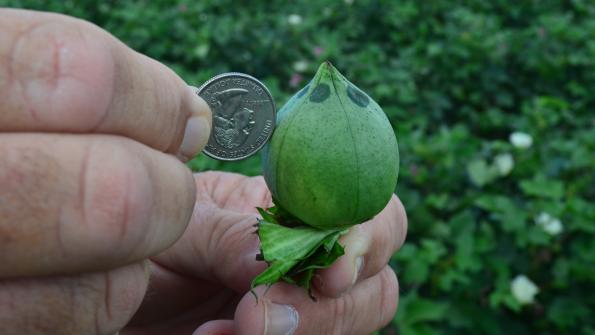
Bacterial blight in cotton has long been an issue in cotton production areas around the world, affecting mostly upland cotton (Gossypium hirsutum L.)—an estimated 8 million bales of which is grown on some 5.5 million acres of Texas, mostly in the Southern High Plains.
While the Journal of Cotton Science reports bacterial cotton blight outbreaks in the United States are infrequent, serious infections can occur wherever susceptible cultivars are grown. But plant research and resistant cultivars have helped reduce susceptibility of blight in Texas and Oklahoma cotton in recent years—at least until bacterial blight symptoms began to show up on partially resistant, resistant and immune varieties in more recent years.
Last year Bacterial blight was discovered in a field plot near Amherst, Texas, on FiberMax 1830GLT, and on FM 2484 in a field trial near Lubbock. This year, wet, rainy conditions early in the season saw the resurgence of blight in other parts of the Southern High Plains and in limited areas of Oklahoma.
For the latest on southwest agriculture, please check out Southwest Farm Press Daily and receive the latest news right to your inbox.
Dr. Thomas Isakeit, Professor and Extension Plant Pathologist at Texas A&M, says bacterial blight is caused by the bacterium, Xanthomonas citri subsp. malvacearum. It is seedborne, but can survive on residue from infected crops, according to Texas A&M researchers. Yield-damaging outbreaks in susceptible varieties occur if weather conditions during the season are favorable for disease development, specifically, early-season rain that spreads the pathogen throughout the field, followed by heavy, wind-driven rains that occur after canopy formation, with periods of high humidity and temperature.
Isakeit says although symptoms can occur during the seedling stage, the definitive foliar symptoms of angular leaf spots, with water soaking are seen later. These lesions are restricted by veins. Additionally, small, circular brown lesions can occur with the angular leaf spots.
Less-common foliar symptoms include white, dried exudate (dried bacteria) associated with lesions and chlorotic halos surrounding lesions. If these symptoms occur, angular leaf spot symptoms will also occur in a field. The bacterium can also cause blighting of the stem and petioles, which can lead to girdling and breakage.
More Bacterial Blight
Here are images of bacterial blight on cotton
Biologist say if wet weather persists during the growing season, as experienced in parts of the Southern Plains this year, the disease can progress to bracts and flower buds, possibly causing shedding. On developing bolls, circular, water-soaked lesions can occur. These bolls can rot or may fail to open properly, resulting in significant yield losses that range between 20 percent and 25 percent or more in drastic cases.
MANAGEMENT STRATEGY
Fungicides are generally not effective against this disease. Current-season management approaches include maintaining adequate nitrogen fertility and adjusting furrow or sprinkler irrigation to minimize leaf wetness and high humidity within the canopy.
Since the pathogen can persist to the next season on crop residue and infect seedlings as they contact the residue, the field should be rotated out of cotton for at least one season. The pathogen is not known to infect other plant species, including weeds.
Crop residue should be plowed into the soil to hasten decomposition. The bacterium can’t survive in soil. Resistant varieties can be planted, but development of new races of the pathogen remains a possibility.
More Bacterial Blight
Bacterial blight causes damage in excellent Oklahoma cotton crop
NIFA GRANT AWARDED FOR MORE RESEARCH
Researchers at Texas A&M received a U.S. Department of Agriculture (USDA) National Institute of Food and Agriculture (NIFA) grant totaling $289,281 Nov. 16 to fund a project to address the resurgence of bacterial blight of cotton.
According to the grant application, bacterial blight must be controlled for sustainable production of cotton. The research project proposes to collect a diverse set of Xcm (Xanthomonas citri subsp. malvacearum) from Georgia, Mississippi, and Texas, where the disease has demonstrated signs of resurgence.
Researchers believe Xcm injects type 3 effector proteins (T3Es) into plants which help to promote susceptibility in cultivars. The Xcm isolates collected in this project will be characterized for T3Es. In addition, Xcm isolates from Texas will be tested on cotton cultivars differing in their disease response to race 18 of Xcm.
These tests should provide evidence if a race shift is occurring. Another hypothesis suggests the resurgence of the disease is due to an interaction between Xcm and another bacterium. Tests will be conducted in the greenhouse on varieties that should be resistant and susceptible to bacterial blight, using other bacteria that are isolated in close proximity to Xcm.
Researchers say the objective of the project is to determine if and why the situation with bacterial blight in cotton has changed. Specific objectives include:
Obtaining a diverse collection of isolates of Xcm from Georgia, Mississippi, and Texas; Characterize the Type III effectors of these isolates;
Characterize the resistance/susceptibility of these isolates on modern cultivars that differ in their typical response to race 18 of Xcm;
Work with producers to improve their IPM practices with respect to Xcm; and
Quantify changes in practices as a result of the information generated in this project.
The project is expected to begin early in 2017.
About the Author(s)
You May Also Like




